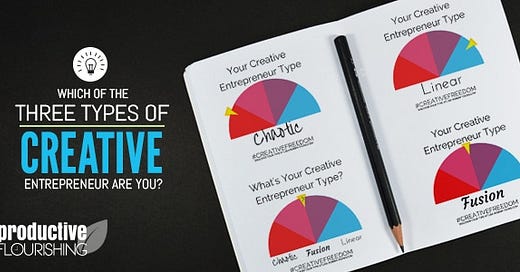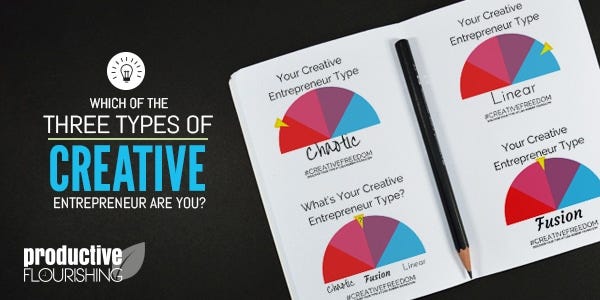Which of the Three Types of Creative Entrepreneur Are You?
Editor’s note: This is a guest post from Lisa Robbin Young.
A few years ago, I was faced with an audience problem. I’d been in business more than 20 years, and my clients were all over the map, both literally and figuratively. When an audience gets too wide to serve effectively, people start falling away — you don’t hold their interest anymore. Once-loyal followers start searching again for the message, insight, and information they originally came to you for — a message that’s now watered down in a far-reaching pile of content that they don’t have the time or energy to sift through.
My list was slowly decaying, and pressure was mounting for me to get clarity about whom I was really meant to serve. What began as an experiment in target marketing evolved into something I hope will be incredibly useful for creatives like you.
My “Sorting Hat” Experiment
Remember the Sorting Hat? That tattered, talking hat from the Harry Potter series? Harry placed the hat on his head and, after a little conversation, got “sorted” into Gryffindor House — his home away from home at Hogwarts.
With an audience too wide to serve effectively, and no easily recognizable demographics to use, I started my own “Sorting Hat” experiment to get more clarity about my audience. Though this post is more about the results than about the actual experiment, I’ll describe it here in case you’re also grasping for market clarity in your own business.
I started by looking at the specific reasons clients came to me for help. For example, one client hired me to be his Marketing Director. That project involved a number of tasks. I wrote each request — either the initial reason someone came to me or one of the individual tasks that eventually became part of a project — on a piece of paper and sorted the papers into piles.
Then I went further by considering what my clients and I ultimately ended up working on together. My marketing client, for example, didn’t have a marketing problem so much as a systems and communications problem. The client’s lack of systems meant that he was the bottleneck in the business. I made a few suggestions, and in less than three months, he went from losing $5-10,000 per month to clearing $2--3,000 (or more) in monthly profit.
Again, every suggestion and task went onto a piece of paper. I sorted by client and by task, looking for commonalities. I’m pretty good at finding patterns, but this was a struggle. At first, I couldn’t see a thing and just kept shuffling the papers around. My kid thought it was some kind of crazy craft project.
Then, I zoomed out a bit and found some common themes. Seventy piles became thirty, then twenty. After several months of sorting, two camps finally emerged: I called them “Chaotic” and “Linear” clients. Inside each of these camps was a wide variety of client types and demographics, but with a few exceptions, my client base seemed to fit into these two groups.
Not as quick and easy as the Sorting Hat, but the process was working for the most part.
Many of the “non-compliant” clients — those who didn’t fit into either camp — were my favorites, and that really bugged me! I wanted to clone my clients to fill my business, so if they didn’t fit my sorting model, why bother? I also felt like I didn’t fit my own sorting model, either. Talk about frustrating!
We weren’t just square pegs, though. Another pattern emerged. A third type of client was stuck firmly in the middle between the two extremes. I called them Fusion types.
Once everyone was sorted, I was able to find one unifying theme amongst all my clients: They were all creative entrepreneurs.
The Creative Freedom Spectrum Is Born
These “camps” weren't really camps at all, but more of a spectrum. At one end is the process-loving Linear Creative, at the other end is the go-with-the-flow Chaotic Creative, and running down the middle is the Fusion Creative. Each creative entrepreneur is a blend of Linear and Chaotic traits, and most people tend to favor one type over the other. Fusions favor neither or both equally, depending on the day.
Why does it matter? As a creative entrepreneur, you’re building a business around doing what you love. There may be times when you wear many hats, but knowing your Creative Freedom type allows you to see the natural blind spots of your type that cause you to wear the wrong hats for too long. When you are clear on not only what you’re good at but also what energizes you, it becomes easier to find and implement support systems for the things that aren’t in your wheelhouse. That way, you can do your Great Work with confidence and build a profitable, sustainable business that you love — without selling your soul.
The Creative Freedom Spectrum identifies your preference, not your proficiency. You can be really good at something and hate doing it. Sometimes you expect that you have to, or “should,” be doing it because you’re a business owner, but that’s a faulty assumption. In fact, several Chaotic Creatives I’ve met are incredibly good at Linear functions, but those tasks drain their energy and leave them feeling depleted at the end of the day. Likewise, a focus on more Chaotic functions, while important in the growth of a business, can drive a Linear to the brink of insanity. When each type focuses on what’s best for them and delegates the other tasks and responsibilities, the result is more time, energy, and money for what matters most.
Which type are you? Read the following descriptions of the three primary types and see if you spot yourself.
Chaotic Creatives
Chaotics need structures that work with their lifestyles. They often self-identify as artistic or creative, and they know how to relax and have fun, but they sometimes feel both anxious about needing to focus and overwhelmed because there’s too much to do. They don’t want to be “penned in” and resist most forms of disciplines or structure that are foisted upon them. Still, they recognize that their laissez-faire approach to business prevents them from creating a consistently profitable business.
Chaotics focus on the experience of their Great Work and aren’t afraid to take big risks in order to reach the right people. How will it look and feel? How will people respond to it? Think Lady Gaga, who confessed in an interview that she plowed every penny she had into a tour in order to impress Arthur Fogel enough to get him to agree to be her promoter.
Chaotic Creatives typically reach a point when they are ready to “get organized and grow.” When these clients come to me, we discover that while they don’t work well with imposed structures, they do have rituals, routines, and other habits that have helped them to create a “groove” that keeps things going. At some point, however, it’s not enough — usually because of consistency issues. They might even be dealing with a chronic illness that prevents them from keeping a regular work schedule. To stay on track and achieve their goals, Chaotics typically need accountability — without pressure. Oftentimes, they need very directive help because they get overwhelmed with too many details.
Linear Creatives
Linears don’t typically identify as creative, but often consider themselves innovators or thought leaders. These are typical “Type A” people who are practically chained to their businesses. It’s hard for them to take a day off -- not because they don’t have a team to keep things running, but because they are so focused on results and profitability that they lose sight of sustainability. Their health and well-being aren’t typically a priority until later in life unless something or someone intervenes. For example, a spouse threatens divorce or a loved one falls ill, requiring them to spend more time away from work and actually learn to live without the daily grind for a while.
In the meantime, they’re focused on efficiencies, systems, processes, and scaling up. How’s it performing? Who’s buying it? How can we streamline this? Think Warren Buffett, the Chairman of Berkshire Hathaway, a multinational company with stock that currently trades well above $200,000 per share.
Linear Creatives typically reach a point when the money isn’t as important as the meaning. When these clients come to me, they are looking to create more impact and have lives worth living. They want the safety and security that come with the money they’re making, and they want to be able to enjoy it, too. Linears typically need permission to loosen up — without guilt — and to trust their highly qualified teams to handle the day-to-day operations of the business. Linears can get lost in the details, so providing big-picture oversight is often helpful.
Fusion Creatives
Fusions live in the middle between Chaotics and Linears because they equally enjoy (and detest) the skills of both types. They may self-identify as “multi-passionate” because they are adept at a variety of things and find it hard to pick just one to pursue. They demonstrate traits of both Linears and Chaotics, almost interchangeably, but the most common telltale traits are perfectionism and comparison-itis.
Fusion Creatives can get stuck in a “perfection loop,” comparing themselves to other Linear or Chaotic Creatives, instead of focusing on their own unique blend of talents and skills: It’s got to be better than everyone else’s, or why bother? If they can transcend the all-or-nothing thinking, Fusions actually have the greatest capacity for fame and fortune. Think of the Eagles, a band of independently successful musicians who together created the best-selling album of the 20th century.
Fusion Creatives typically reach a point when they’re tired of being busy and not seeing a return on their investment. When these clients come to me, they are ready to have a consistently sustainable and profitable enterprise. They typically need permission to act with confidence — without being compared to others — and to trust that whatever project they choose to complete will be successful, because it probably will be.
Which Type Are You?
While not exhaustive, these descriptions can help you see your potential blind spots and start making small shifts today to improve your own creative enterprise. Want to know which type you are? Take the free quiz to learn about the “Cusp” types, as well as more specifics on how to build your creative empire around who you are and how you prefer to show up in the world.
Because, just like Harry Potter, you have some say in how you get sorted in this world. Why not choose what works best for you?




